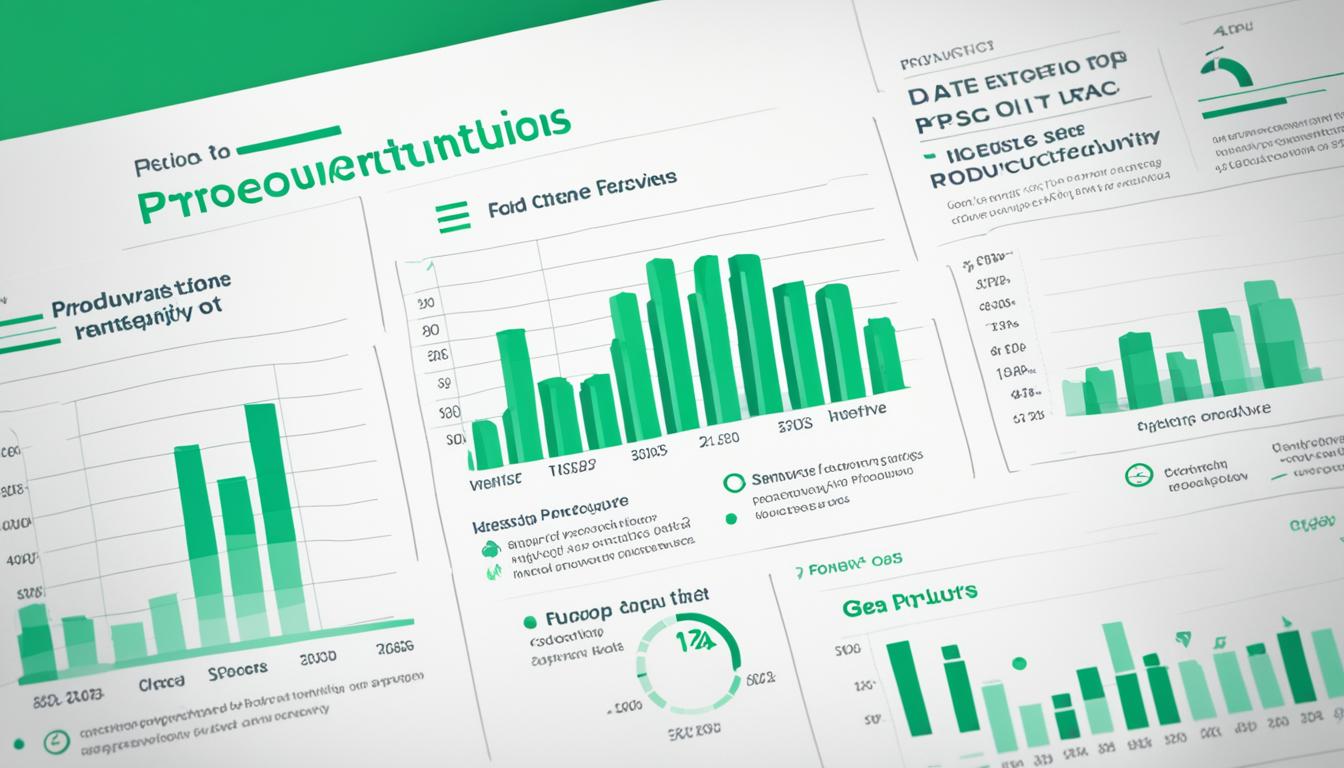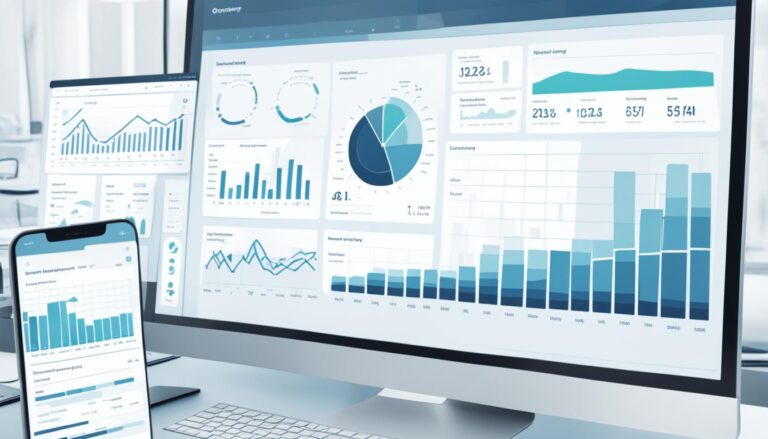Elevate Your Team with Monitoring Employee Productivity

Do you know how productive your team truly is? Can you confidently measure and analyze their performance? In today’s fast-paced work environment, monitoring employee productivity has become more crucial than ever before. But how can you effectively track and enhance their output without infringing on their privacy or creating a culture of surveillance?
Discover the power of employee monitoring software and productivity tracking tools that can revolutionize how you manage and optimize your team’s performance. Learn how to utilize these tools to empower your employees, foster a thriving work environment, and unlock their full potential.
In this article, we will explore practical strategies and best practices for monitoring employee productivity. From the observation/value trade-off to defining clear goals and expectations, choosing the right productivity tracking tools, monitoring workload, and fostering a culture of continuous improvement, you will gain valuable insights to elevate your team’s performance.
Key Takeaways:
- Monitoring employee productivity is essential for maximizing efficiency and optimizing performance.
- Utilize employee monitoring software and productivity tracking tools to measure and analyze performance effectively.
- Involve employees in the monitoring process and provide them with access to their own performance data.
- Define clear goals, key performance indicators (KPIs), and expectations to align employee efforts with company objectives.
- Choose the right productivity tracking tools that offer a user-friendly interface, real-time tracking, and customizable metrics.
The Observation/Value Trade-Off
Employee satisfaction and privacy are paramount when considering the delicate balance between observation and value in the workplace. According to a recent Harvard Business Review survey, 90% of employees are open to their employers collecting and utilizing data on their work, but only if they perceive personal benefits. Employees want assurance that their data is being used responsibly and not against their interests.
To achieve an optimal observation/value trade-off, it is crucial to involve employees in the process and provide them with tangible value through access to their own performance data. Sharing the goal of the effort with employees helps build transparency and trust. By including employees in the decision-making process and empowering them with access to their own data, employers can foster a sense of ownership and agency, ultimately bolstering employee satisfaction and privacy.
To illustrate the observation/value trade-off, consider the following benefits:
- Increased Employee Satisfaction: When employees have access to their own performance data, they can gain valuable insights into their strengths and areas for improvement. This empowers employees to take ownership of their professional development and make informed decisions to enhance their performance and job satisfaction.
- Enhanced Performance Management: By providing employees with visibility into their performance data, employers encourage accountability and enable open dialogue around performance. This fosters a culture of continuous improvement and growth, as employees can identify specific areas to focus on and proactively address any performance gaps.
- Improved Goal Alignment: Giving employees access to their performance data allows them to align their own goals with the broader objectives of the organization. This alignment facilitates collaboration and ensures that individual efforts contribute to the overall success of the team and company.
By striking the right balance between observation and value, employers can not only monitor productivity effectively but also cultivate a sense of empowerment and satisfaction among their employees. Through transparent communication, involvement, and the provision of meaningful benefits, organizations can achieve a harmonious observation/value trade-off and create a work environment that prioritizes employee satisfaction and privacy.

Define Clear Goals and Expectations
Defining clear goals and expectations is essential for effectively tracking and managing employee productivity. By establishing specific objectives and communicating performance targets, you provide your team with a clear sense of direction and purpose. This clarity enables employees to align their efforts with company goals, ensuring optimal performance and accountability.
Identifying Key Performance Indicators (KPIs)
To measure progress towards your goals, it is crucial to identify key performance indicators (KPIs) relevant to each objective. KPIs help you track and evaluate specific metrics that directly contribute to the overall success of your team. Whether it’s revenue growth, customer satisfaction ratings, or project completion rates, KPIs provide quantifiable benchmarks that enable objective measurement and analysis.
Setting Realistic and Challenging Goals
Clear goals should strike a balance between being realistic and challenging. Realistic goals ensure that employees have a target that is achievable within their capabilities and available resources. Challenging goals inspire individuals to push their limits, driving innovation and personal growth. By setting the right level of difficulty, you encourage motivation and a constant drive for improvement.
Aligning Goals with Company Values
Goals should align with the core values and mission of your organization. By ensuring that objectives are in harmony with your company’s vision and culture, you create a sense of purpose and a shared sense of responsibility among employees. This alignment fosters a cohesive team environment and fuels enthusiasm, as individuals see a direct correlation between their work and the success of the organization.
Providing Clarity on Priorities and Timelines
Clearly communicate priorities and timelines for goals to your team. This ensures that everyone understands the order of importance and urgency, enabling them to allocate their time and resources effectively. When employees have a clear understanding of what needs to be done and by when, they can prioritize their tasks and make informed decisions on how to achieve their goals.
Regularly Reviewing and Updating Goals
Goals should not remain static but evolve as circumstances change. Regularly review and update goals to align with shifting market conditions, business strategies, and individual growth. By adapting goals in response to new challenges and opportunities, you keep your team focused and agile, ensuring continuous progress and improvement.
Involving Employees in Goal-Setting
Engage your employees in the goal-setting process to foster a sense of ownership and commitment. Solicit their input, listen to their ideas, and incorporate their feedback. By involving employees in goal-setting, you promote a collaborative culture where everyone’s perspective is valued and contributes to the success of the team.
Choose the Right Productivity Tracking Tools
When it comes to accurately measuring and monitoring employee performance, choosing the right productivity tracking tools is essential. These tools not only provide insights into employee productivity but also streamline task and project management, leading to enhanced efficiency and overall team performance.
Here are some key factors to consider when selecting productivity tracking tools:
- User-friendly interface: Look for tools that have a user-friendly interface to ensure easy adoption and seamless integration into your workflow.
- Compatibility: Choose tools that are compatible with your existing systems to avoid any disruptions or compatibility issues.
- Real-time tracking: Opt for tools that provide real-time tracking and reporting capabilities to stay updated on employee progress and identify areas for improvement immediately.
- Customizable metrics: Select tools that allow you to customize metrics and key performance indicators according to your specific business needs and goals.
- Mobile accessibility: Ensure the tools you choose are accessible on mobile devices, allowing employees to track their productivity on the go.
- Data security: Prioritize tools that prioritize data security and privacy to protect sensitive employee information.
- Automated time tracking: Look for tools that automate time tracking processes, freeing up valuable time for both employees and managers.
- Task and project management features: Consider tools that offer task and project management features, enabling seamless collaboration and streamlined workflows.
By carefully evaluating these factors and selecting the right productivity tracking tools, you can empower your team to work more efficiently, improve performance, and achieve business objectives.
![]()
Comparison of Top Productivity Tracking Tools
| Tool | User-Friendly Interface | Real-Time Tracking | Customizable Metrics | Mobile Accessibility | Data Security | Automated Time Tracking | Task and Project Management Features |
|---|---|---|---|---|---|---|---|
| Tool A | Yes | Yes | Yes | Yes | Yes | Yes | Yes |
| Tool B | Yes | Yes | No | Yes | Yes | No | Yes |
| Tool C | No | Yes | Yes | Yes | Yes | Yes | No |
Monitor Workload and Avoid Burnout
Monitoring your team’s workload and preventing burnout is crucial for maintaining productivity and ensuring the well-being of your employees. By implementing effective strategies and utilizing productivity tracking tools, you can create a healthy work environment that promotes high performance and work-life balance.
Establish Reasonable Workloads
One of the key factors in preventing burnout is setting reasonable workloads for your employees. Overloading them with excessive tasks and responsibilities can result in stress, decreased productivity, and potential burnout. Take the time to assess each team member’s capabilities and workload capacity, ensuring that they have a manageable and achievable amount of work.
Utilize Productivity Tracking Tools
Productivity tracking tools can help you monitor your team’s workload and identify any potential bottlenecks or areas of improvement. These tools provide valuable insights into how your employees are spending their time and allow you to make data-driven decisions to optimize their efficiency. By tracking their progress and providing feedback, you can ensure that workloads are balanced and manageable.
Encourage Open Communication
Open communication is essential in preventing burnout. Encourage your employees to openly discuss their workload, concerns, and challenges they may be facing. By fostering a culture of transparency and trust, you can identify and address potential issues before they escalate. Regular check-ins and team meetings provide opportunities for your employees to express their needs and for you to offer support.
Regularly Review Deadlines
Reviewing deadlines on a regular basis can prevent workload imbalances and reduce stress. By assessing the urgency of tasks and adjusting deadlines accordingly, you can ensure that your team has a manageable workload and enough time to complete their assignments successfully. Avoid overloading employees with tight deadlines and provide sufficient time for them to produce quality work.

Offer Flexibility and Autonomy
Flexibility and autonomy can significantly contribute to preventing burnout. Allow your employees to have some control over their work schedules and methods, enabling them to manage their workload in a way that suits their productivity and personal preferences. Trusting your team members and giving them the freedom to make decisions empowers them and reduces the risk of burnout.
Recognize and Reward Hard Work
Recognizing and rewarding hard work is essential for maintaining motivation and preventing burnout. Acknowledge your employees’ efforts and achievements, both individually and as a team. Show appreciation for their dedication and commitment, and consider implementing a rewards system to further incentivize exceptional performance. Recognizing their hard work builds morale and encourages productivity.
Implement Employee Assistance Programs
Employee assistance programs (EAPs) can be instrumental in preventing and managing burnout. EAPs provide resources and support to employees dealing with personal and work-related challenges. These programs offer counseling, stress management techniques, and other resources that can help employees maintain a healthy work-life balance and build resilience.
Train Managers in Workload Management
Effective workload management starts with well-trained managers who can allocate tasks efficiently, provide proper guidance, and support their team members. Offer training programs and resources to enhance their skills in workload management, communication, and stress management. Equip them with the tools they need to effectively monitor and support their employees’ workloads.
Conduct Employee Surveys
Regularly gather feedback from your employees through surveys to assess their workload satisfaction, identify potential areas of improvement, and address any concerns. Employee surveys provide valuable insights into their experiences and can guide you in making necessary adjustments to prevent burnout. Act on the feedback received to continuously improve the work environment.
By monitoring workload and implementing strategies to prevent burnout, you can create a positive work culture that prioritizes employee well-being and ultimately leads to higher productivity and job satisfaction.
Foster a Continuous Improvement Culture
To foster a culture of continuous improvement within your organization, it is essential to prioritize certain key elements. Encouraging employee feedback, promoting peer-to-peer collaboration, emphasizing data-driven decision making, conducting regular performance evaluations, and providing ongoing training and development opportunities are all crucial for creating a culture of continuous improvement. By embracing these practices, you can cultivate a workforce that consistently seeks better ways to work, optimizes processes, and strives for excellence.
Encouraging Employee Feedback
One of the foundational aspects of continuous improvement is encouraging open and honest employee feedback. When employees feel comfortable sharing their thoughts, ideas, and suggestions, they become active contributors to the growth and development of your organization. Create an environment where feedback is valued, actively listen to your employees, and respond to their suggestions. This fosters a sense of ownership and empowers individuals to contribute to the improvement of processes and workflows.
Promoting Peer-to-Peer Collaboration
Collaboration among peers plays a vital role in fostering a continuous improvement culture. Encourage employees to collaborate, share knowledge, and learn from one another. Provide opportunities for cross-functional teamwork, organize brainstorming sessions, and create platforms for knowledge sharing. When employees work together towards a common goal, they can leverage their collective strengths and expertise to generate innovative ideas and improve performance.
Emphasizing Data-Driven Decision Making
Data-driven decision making allows organizations to make informed choices based on objective evidence rather than subjective opinions. Encourage employees to rely on data when making decisions and provide them with the tools and resources necessary to access and analyze relevant data. By emphasizing the importance of data and its role in driving improvements, you create a culture that values accuracy, efficiency, and continuous learning.
Conducting Regular Performance Evaluations
Regular performance evaluations provide valuable insights into an employee’s strengths, areas for improvement, and overall contribution to the organization. Establish a systematic performance evaluation process that includes clear performance metrics, structured feedback sessions, and goal setting for professional development. These evaluations not only help identify areas for improvement but also recognize and reward outstanding performance, motivating employees to continuously enhance their skills and capabilities.
Providing Ongoing Training and Development Opportunities
Continuous improvement requires a commitment to ongoing learning and development. Offer employees opportunities to enhance their skills, acquire new knowledge, and stay updated on industry trends. This can include workshops, seminars, online courses, mentorship programs, and conferences. By investing in their professional growth, you empower employees to contribute to the organization’s continuous improvement goals while also increasing job satisfaction and retention.
By fostering a culture of continuous improvement through employee feedback, peer-to-peer collaboration, data-driven decision making, regular performance evaluations, and ongoing training and development, you can create an environment where innovation thrives, efficiency improves, and individuals are motivated to reach their full potential.
Benefits of a Continuous Improvement Culture
| Benefits | Description |
|---|---|
| Enhanced Productivity | A continuous improvement culture encourages employees to find more efficient ways of working, leading to increased productivity and output. |
| Improved Efficiency | Continuous improvement processes streamline workflows and eliminate unnecessary steps, resulting in improved efficiency and resource utilization. |
| Higher Quality Output | By continuously seeking improvement, employees can identify and address quality issues, resulting in higher-quality products or services. |
| Innovation | A continuous improvement culture fosters a mindset of innovation, encouraging employees to explore new ideas and approaches. |
| Employee Engagement | When employees are actively involved in the improvement process, they feel a greater sense of engagement and satisfaction in their work. |
| Adaptability | A continuous improvement culture helps organizations adapt to changes in the market, technology, and customer needs more effectively. |
| Competitive Advantage | Organizations that embrace continuous improvement gain a competitive edge by continuously evolving and staying ahead of the competition. |

Conclusion
Monitoring employee productivity is crucial for maximizing efficiency, optimizing performance, and fostering a thriving work environment. By implementing the strategies outlined in this article, you can elevate your team and unlock the full potential of your employees. It’s all about finding the right balance between observation and value, clear goal-setting, choosing the right productivity tracking tools, monitoring workload, and fostering a culture of continuous improvement.
When you monitor employee productivity, you gain valuable insights into their performance, identify areas for improvement, and make data-driven decisions to enhance efficiency. With the right productivity tracking tools, you can easily analyze productivity metrics, track progress in real-time, and customize key performance indicators to align with your business goals.
Additionally, by monitoring workload and preventing burnout, you create a supportive work environment where employees feel valued and motivated. By recognizing their hard work and providing flexibility and support, you can ensure a healthy work-life balance and enhance overall productivity.
Finally, fostering a culture of continuous improvement encourages collaboration, feedback, and ongoing development. By empowering your employees to contribute ideas, make data-driven decisions, and continuously enhance their skills, you create an environment that thrives on innovation and excellence.






